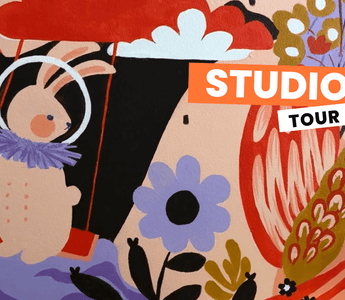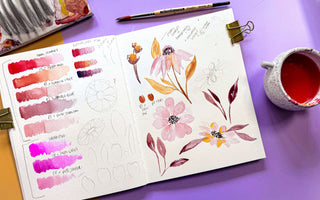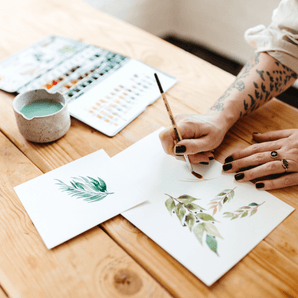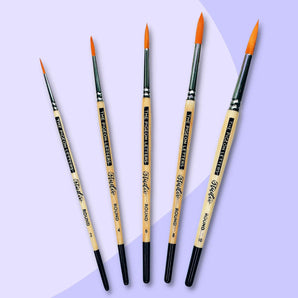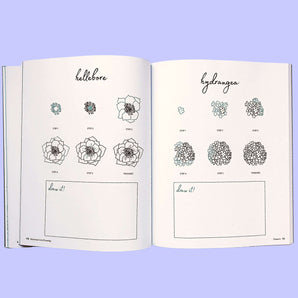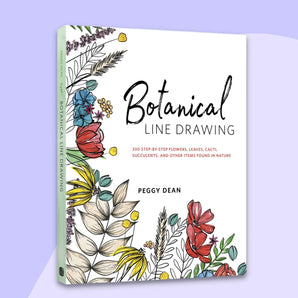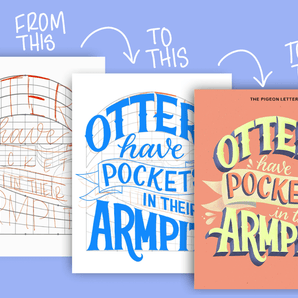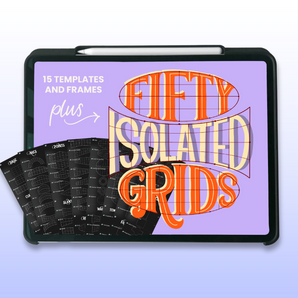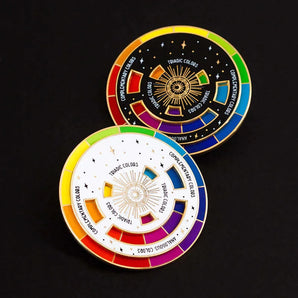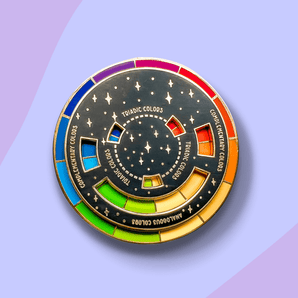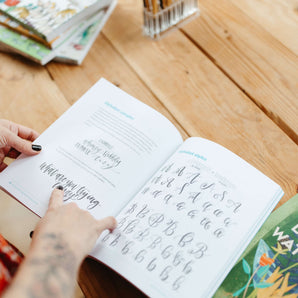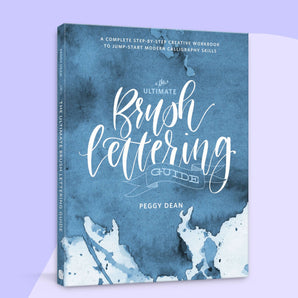Today, I’m taking you behind the scenes into my personal process of how I have designed a workspace that's not just functional but also a sanctuary of inspiration and creativity for me. I firmly believe that your workspace plays a pivotal role in nurturing your artistic spirit.
Before we dive into the nitty-gritty details, let me share a bit about why this topic means so much to me. You see, as a creative entrepreneur, I've been through my fair share of challenges. There were times when I struggled to find the right balance between work and creativity, and my workspace felt more like a hindrance than an ally. And since I work from home, I started feeling like when I was home, I was at work. Period.
I remember those days when my workspaces didn't quite 'click.' It affected my productivity, stifled my creativity, and left me feeling uninspired, and it’s taken me a while to embrace that my surroundings can be ever-changing and evolving to match where I’m at—right now—in order to do my best work.
So today, I'm sharing not just how I not only overcame those challenges but also designed a workspace that truly keeps me inspired every single day. I want you to feel that same spark of creativity whenever you step into your creative nook, whether it's a cozy corner or a dedicated studio.

Before I take you through my setup, let's look into the very essence of why having a dedicated creative workspace is an absolute game-changer for us.
First things first - Why is a dedicated creative workspace so crucial for artists? Well, imagine trying to write a book in the midst of chaos and distractions. You can’t catch a butterfly in a storm, you know? Pls don’t try to catch a butterfly though.
As artists, we thrive on focus, inspiration, and the ability to let our creative juices flow freely. And that's where our workspace comes into play. It's not just a physical location; it's your sanctuary, your cocoon of creativity. The right environment can do wonders for your productivity and creativity.
Fancy watching me talk instead?
Identifying your unique needs
Here's where your personal workflow, materials, and comfort levels come into play. Believe it or not, your workflow can indeed be seamless. For instance, if you're a calligrapher, having a variety of pens and inks readily accessible can save you precious time and keep your inspiration flowing, knowing you won’t be battling a long setup.
And regarding comfort… please, for the love of your precious body, don’t choose the most aesthetic chair if it’s not going to support you. I've experienced the consequences of overlooking ergonomics firsthand. I used to use a chair that didn't provide proper back support and a desk that was pretty but made my legs feel like they had to squeeze underneath it because of aesthetically pleasing built-in drawers. It resulted in not wanting to spend much time there. Think about your favorite chair in your home to relax in. It makes you feel at ease. The same goes for your workspace chair and desk or table.
Choose a chair with lumbar support to keep your back happy during those long painting or designing sessions. Adjustability is key to fine-tune it to your unique body.
This could come in the form of an ergonomic, spinning chair, like the one I have:

Or if you already have a chair you love but want to make it extra comfortable, this seat cushion might just be a game-changer for you, too:

Your creative journey should be a joy, not a strain.
Comfort aside, there are plenty of things that it’d be ideal to have readily accessible. I realized that I often needed quick access to my books when I instruct online. So, I created a dedicated shelf right above my workspace to hold those books. It might seem small, but it’s made a world of difference. Not to mention, depending on the angle, I’ve got subliminal marketing built in right above me!
I want you to ask yourself the following questions:
WORKFLOW
- How do you typically work on your creative projects? (e.g., digital, traditional, mixed media)
- Are there specific stages in your creative process that require distinct workstations or tools?
- Do you need space for reference materials, sketching, or brainstorming?
MATERIALS
- What are your primary art mediums and tools? (e.g., watercolors, acrylics, digital tablet)
- Do you have a variety of materials that need organized storage? (e.g., paints, brushes, markers)
- Are there specific materials you use frequently that should be easily accessible?

COMFORT & ERGONOMICS
- How long do you typically spend working on your art projects in one sitting?
- Is your current workspace chair and desk setup comfortable for extended periods?
- Do you have proper lighting to reduce eye strain during your creative sessions?
Alright, I want to get specific. When I started out, my workspace couldn’t have been farther from a natural light source. We lived in a 600 sq ft apartment and the option just wasn’t there for me to set up in a semi-permanent way anywhere other than the small nook off the kitchen that they called a dining area. It was more like a large hallway. Knowing that I didn’t have the option, I looked into lighting that would help. It was ugly at first because I didn’t understand that non-LED lights would cause banding on video, or that mixing lighting temperatures was the reason my colors never looked quite right. But the more I committed to establishing what worked for me and my unique circumstance, the better I was able to perform.
Fast forward a few years, and we’re in a house. I chose to make my workspace in a spot with natural light, looking out to our little garden. It was a game-changer. The bright, natural light lifted my spirits, and the peaceful environment, sweet critters included, allowed my creativity to flourish, encompassing all the hats I need to wear.
So if you’re able to, settle into a space that bathes you in natural light during the day. Here's something to ponder though: if you're a night owl and do your best work in the evening, consider the lighting at that time. A well-lit workspace, even during nighttime, can keep your creative fires burning.
My favorite lighting:
Pancake Light

LED Panels

Canvas Lamp

*Get a cute discount with PIGEONLETTERS10 at checkout!* And don't forget that I have an unboxing and first impressions of this lamp right over here.
Reducing distractions is equally vital. If you have a choice, avoid high-traffic areas where family members or roommates often pass through. Your creative space should be your sanctuary, a place where you can fully immerse yourself in your art. I recognize that this isn’t always easy, so I’ve got some more questions I want you to consider:
WORKSPACE
- Where is your current workspace located, and how does it affect your creative focus?
- Are there any distractions in your workspace that hinder your productivity?
- Can you designate a quiet and well-lit area for your creative activities?
Now, I suggest that you take a moment to assess your available spaces. Whether it's a corner of your living room, a spare bedroom, or even a dedicated studio… Think about how the natural light changes throughout the day and whether there are any distracting elements. Being directly under a window is great, sure, but mine just so happens to be north-facing, making it difficult to snag good lighting without the assistance of artificial lights. Otherwise, late afternoon is my brightest time, so I know that’s my window (no pun intended) to really lean into my creativity. Your goal is to create a space where you can dive into your own creative flow effortlessly.
Organizing your tools and materials
Ok, this isn’t just about tidiness and comfort; it's about unlocking your creative potential by eliminating distractions and staying focused on what gets you the most productive. I was so surprised to find out a little productivity hack about myself that I’ll share in a moment. I’m thinking you might surprise yourself too.
In the early days of my artistic journey, my workspace resembled a chaotic art supply store after a tornado. Sometimes it felt like I was spending more time searching for or deciding on the right brush or color than actually creating. It was frustrating.
An organized workspace enhances focus. “Duh Peggy” - Sure, I get it.. “duh”, but listen.. it’s a small thing we can commit to doing for ourselves that clears the path for your creative thoughts to flow freely. When you know where everything is, you are more free to pour your energy into WHAT you want to create and you can channel your energy into your art.
Ready for some practical tips?
- Consider using transparent containers for your paints, markers, and brushes. This makes it easy to see what you have at a glance. Label them if needed.
- Create designated zones for different art mediums. For example, have a section for watercolors, another for acrylics, and so on. It reduces the time spent rummaging through supplies.
- Utilize vertical storage. Shelves, pegboards, and wall-mounted organizers can save precious workspace real estate and keep your materials within reach.

But here's the real magic: the journey to an organized workspace is a personal one. I've had my fair share of trial and error. Some of you might find that organizing by color or by frequency of use works best for you. Your path might be different, and that's perfectly fine. What matters is finding a system that resonates with you and your creative process.
I had originally put everything in organizers so I could see anything I wanted to grab. It was always up, easy to access, easy to dive in. But… I wasn’t creating. I realized that my brain actually needed restrictions. It needed the options to be removed so I could be intentional with what supplies I wanted to use based off of what my gut was saying I wanted to create. So rather than packing everything up, I merged these ideas together. I keep my supplies in transparent trays tucked neatly inside aesthetically pleasing drawers.
Remember that organization isn't just about appearances; it's about boosting your creative flow.
Ask yourself these questions…
ORGANIZATION & EFFICIENCY
- How organized is your current workspace, and what areas need improvement?
- Are there storage solutions or organization tools that would enhance your workspace?
- Can you create dedicated zones for specific creative tasks to improve workflow?

Personalization
Ok, onto my favorite part: personalization in your creative workspace. This is where the magic truly happens as you infuse your unique personality into your creative haven.
In the early days, my workspace was generic, uninspiring, and devoid of personal touches. It felt like I was working in a sterile environment. My creativity struggled to flourish. Personalization can be your muse. When you surround yourself with things that resonate with you – colors, art, quotes, mementos – it creates an environment where inspiration thrives. Now, let me share how I added personal touches to my workspace. It's an ongoing journey filled with small but meaningful steps.
Some ideas for you might be
- quotes that resonate with your creative journey. They can serve as daily reminders of your artistic goals and aspirations.
- display artwork that you love. It could be your own creations, pieces from artists you admire, or even family art. I’ve got a mix of all three.
- incorporate colors that inspire you. For me, I’ve gone through phases of the soothing greens and browns in nature, all the way to this energy drink for the eyes with vibrant red, peach, and purple.

And my goodness. The power of color has such a profound impact on your creativity. Color can evoke feelings of tranquility, energy, or even excitement. By choosing the right color scheme for where you’re at right now, you can set the tone for your creative sessions and enhance your artistic flow. Consider how you want to feel during your creative moments. You can incorporate colors that lean into these feelings into your workspace through paint, decor, and even furniture. And you can start small, maybe by adding colorful cushions, artwork, or even a vibrant rug that resonates with your creative style.
Your workspace should reflect your passions, your dreams, and your quirks. It's a canvas where you're both the artist and the masterpiece. So, my message to you is simple: don't be afraid to decorate your space with items that inspire you. It could be a seashell from a memorable beach trip, a vintage typewriter, or a cherished family photograph. The possibilities are endless.
Make it uniquely yours, and you'll find that every time you step into it, you're greeted by an old friend – inspiration.
Creating a balanced work-life environment
Ok, all this being said, there’s a delicate art of creating a balanced work-life environment within your creative workspace when it’s also your home. If it’s not at home, you’ll have an easier time here, but bear with me because there’s always nuggets to walk away with.
You want to ensure that your sanctuary doesn't become a 24/7 workspace. The key here is to set boundaries so your creativity is nurtured without burnout.
- First, your designated workspace is your creative nook. This is your 'work zone.' When you step into this zone, you're in work mode. When you step away, it's time for personal life.
- Second, set clear working hours and stick to them. Just like a traditional job, having a schedule ensures you don't overwork or blur the lines between work and leisure.
- Third, invest in technology or physical boundaries. If possible, stick to a different room, or use dividers or curtains to physically separate your workspace from the rest of your living space.
And if you, like me, love a hot cup of tea throughout your day to keep you energized, consider setting up a cute tea station nearby.

Maintenance of your creative workspace
Now, just as we maintain organization of supplies and tools, we must maintain our workspace to ensure it remains a source of focus and inspiration.
Let's start with the first question:
- How can you maintain a clutter-free workspace to boost focus and creativity?"
Clutter can be the enemy of creativity, so it's crucial to regularly declutter your workspace. Set aside time each week or month to go through your materials and supplies. Donate or recycle items you no longer need, and organize what remains."
Next, establish routines and habits to keep your workspace organized. Consistency is key. Make it a habit to clean up your workspace at the end of each work session. File away loose paper, clean brushes, shut down any tech, and return supplies to their designated spots. It might seem small, but these routines maintain order and save you time. When you walk into your workspace next, you’ll be thanking yourself for a clean slate.
- What routines or habits can you establish to keep your workspace organized?
The last question is a fun one because it allows you to pivot. Creative people love changing their mind. 😂
- Do you have a plan for periodically evaluating and optimizing your workspace?
Your needs and preferences may change over time, so it's essential to review and optimize your workspace periodically. Consider doing this every few months. Assess what's working and what needs improvement.
Remember, just as we continually refine our skills and explore new outlets, our workspace is a canvas too. With dedication and care, you can ensure it remains a place where inspiration knows no bounds.
I’ve compiled all of the questions I’ve asked in this session into a downloadable worksheet for you as actionable steps to guide you in customizing your creative workspace to align perfectly with your artistic needs and preferences.
As you craft your perfect creative sanctuary, let's take a moment to recap some key points we've explored.
- We've learned that your workspace is not just a physical location; it's your cocoon of creativity, a place where inspiration thrives.
- We've emphasized the importance of customizing your workspace to suit your unique needs, whether you're a watercolor artist, a digital creator, or anything in between.
- We've delved into the significance of location, ergonomics, organization, personalization, and the magic of colors and decor in enhancing your creative flow.
- We've explored the need to set boundaries for a healthy work-life balance
So, remember, your workspace is more than just a place to create; it's a reflection of your artistic journey and a catalyst for your imagination.
Until next time, my fellow creators, stay organized, stay inspired, and keep nurturing your artistic spirit.

Featured supplies list:
- best seat pad ever
- adjustable spinning chair
- cabinet splurge
- Canvas lamp (10% off with PIGEONLETTERS10)
- acrylic wall calendar
- cute tiny kettle
- Ember mug (the biggest game-changer!)
- pancake light
- LED panel light
- acrylic upright pen holders
- acrylic trays
- my favorite speaker
- standing desk anti-fatigue mat

